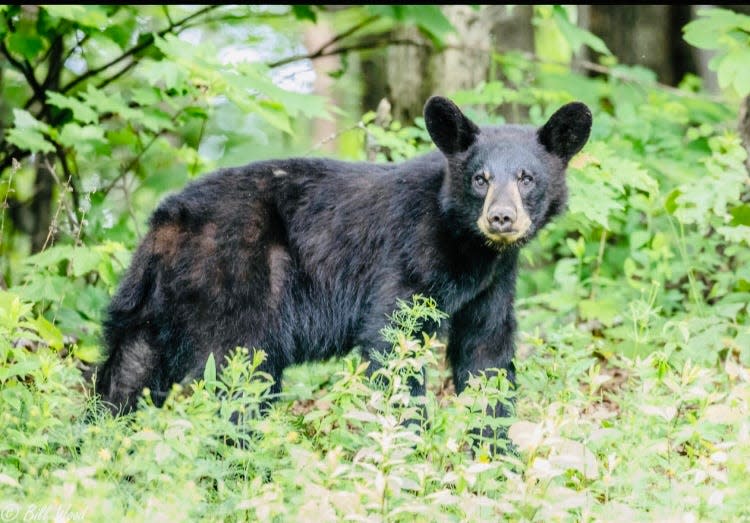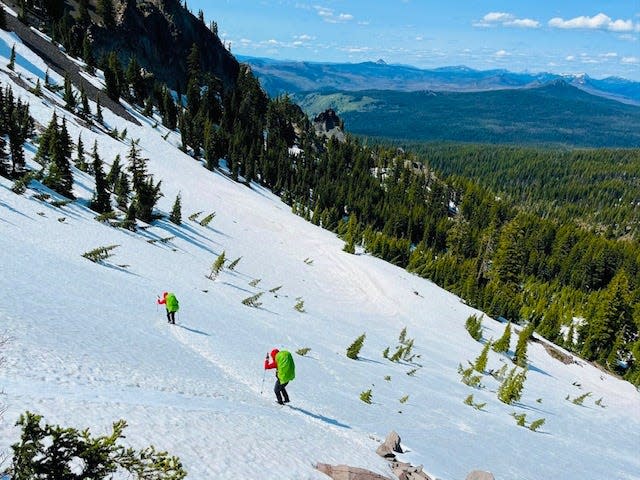A Hiker's Path: A close encounter with bears on the Pacific Crest Trail
I have been writing about my adventures in Oregon on the Pacific Crest Trail. Last week, I finished talking about our stay at Fish lake.
After we got back on the trail, we headed north. Soon we would be walking through an old burn zone where water would be scarce and so would the forest canopy that would provide shade to protect us from the summer sun.
Forest fires are an issue in the western United States. This particular fire happened in July of 2014. It was started by a lightening strike and burned 3,023 acres by the time it was put out.
Catch up with A Hiker's Path: Views of Mt. McLaughlin and a stop at Fish Lake on hike of Pacific Crest Trail
It can take decades for a forest to recover after a burn. It had been almost 10 years since this fire. It was sobering for us to hike through this burn zone in such a beautiful forest.
It also turned out to be a very hot day for us so we carried extra water and drank a lot of it as well.
After a couple of days, things improved on the trail. We were getting closer to the infamous “Devil’s Peak.”It’s a mountain peak that is 7,582 feet in elevation.
The trail would lead us over the “saddle” of the mountain which sits at 7,300 feet elevation. A “saddle,” is the lowest point between two mountain tops, and is often where a trail crosses the mountains.
We had heard that there was a lot of residual snow left on the northern side of the mountain. It had been a harsh winter in the Cascades. Even with hotter temperatures, it takes awhile for deep snow to melt. So we decided to camp below the mountain and climb it in the morning when we were well rested.
So we found a few campsites and set up our home for the night.
One thing we had learned over the past few years of backpacking was to cook our dinner at least a mile away from where we had camped. We were in bear country and it is said that most black bears can detect the smell of food at least a mile away.

Oregon has an estimated population of 25,000-30,000 black bears, and yes, we were hiking through a big forest which was their home. So far, we hadn’t had any encounters with any bears (much to my relief).So we had our dinner, hiked a mile further, and camped for the night.
Our friend camped near us and soon we were all fast asleep in our tents.
At about 4:30 a.m., we were rudely awakened by a strange sound. It was sort of a “gruff” grunting sound. Instantly awake and straining to listen in the deep quiet of the forest, the sound was echoed by two, fainter grunts off in the distance. Again, the first grunt, only this time it sounded a bit closer to where we were camped.
The realization came to all of us at the same time: Bears!
I remembered reading about how black bears sometimes communicate with one another using grunts. They use it for locations as well. So these bears were probably talking to each other about where there were going. That's my educated guess. But our bear’s grunts were getting closer and closer to our tents. We all sat with bated breath, wondering what to do next. I grabbed our emergency beacon just in case.
The suspense was building. Finally after the last grunt we heard, we realized the bear was within about 100 feet of our tents. Our imaginations were on overload. It sounded big. All at once, one of my friends got out of the their tent, stood, waving their arms, and said: “Go away bear!"
Like magic, the grunts stopped. All was silent again. The bear had retreated and the crisis averted. We all breathed great sighs of relief.
The light of sun was beginning to peek up over the mountains. We broke camp quickly and quietly in hopes of avoiding another bear encounter. Anxiety ran high for a bit and after we settled down, we realized we were getting quite close to the summit of the Devil’s Peak saddle.
At some point we had entered into small snow fields that were getting longer and deeper.
We crossed a few precarious “sketchy” areas, but overall it didn’t seem as bad as all of the stories we had heard. That is not until the trail took a sharp turn to the left.

My friend ahead of me was first to see it and few expletive phrases were heard by those of us following. We all came face to face with the dreaded “north side” the the Devil’s Peak. The stories were true. It was very steep and snow covered. What day this was turning out to be: First the grunting bears, now Devil’s Peak. I could see how it earned its name.
Everyone in my group decided we all could conquer the slope so we trudged forward in the soft, steep snow, descending the mountainside.
I will not say what was going on in my head, but you can imagine.
Finally, the decision was made to “glissade” down the slope. Glissading is the act of sitting down and sliding down the snow like you are sledding, except without the sled. It’s a French word that means "to slide."So slide we did.
It’s very common for mountain climbers and backpackers to glissade down snowy slopes when it's safe to.
It was finally my turn and I went like the others before me. I screamed and yelled and howled all the way down. Everyone was laughing once we got down that peak. I know I will remember it for a long time. And my slide was caught on video.
Moving on, back on our trail and out of the snow, we stopped for lunch. Later we would camp right outside of our biggest destination: Crater Lake National Park. That’s a story for next week!
For now, I leave you with this quote for your week: ”When you are where bears live, you learn to pay attention to rhythm of the land and yourself.” — Linda Jo Hunter, writer
Until the next trail,Susan
This article originally appeared on The Herald-Times: A Hiker's Path: Bears and a glissade on the Pacific Crest Trail

